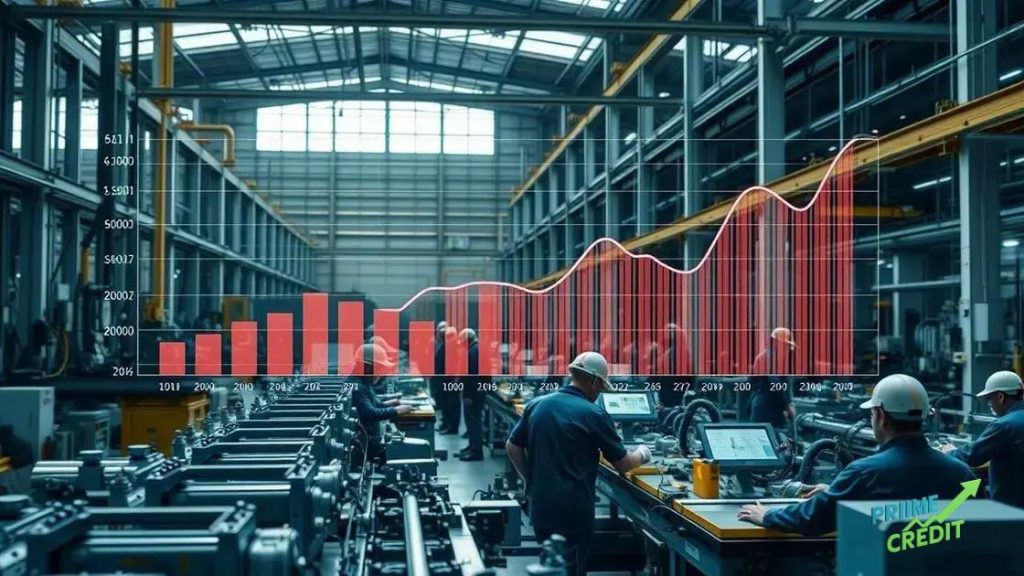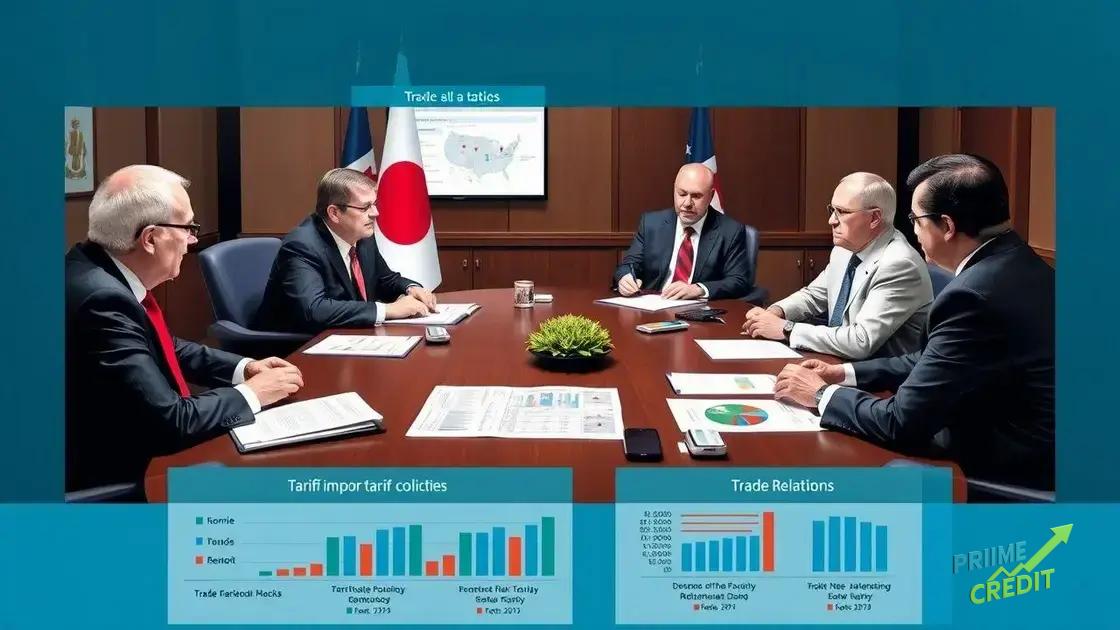Influence of tariffs on U.S. manufacturing sector

The influence of tariffs on the U.S. manufacturing sector affects production costs, employment, and supply chain dynamics, while requiring businesses to adapt their strategies to maintain competitiveness.
The influence of tariffs on the U.S. manufacturing sector is a topic that invites much discussion. Have you considered how these trade policies shape the landscape of production, jobs, and economic health? Let’s dive deeper into this complex subject.
Overview of tariffs and their purpose
Understanding tariffs and their purpose is essential for navigating today’s economic landscape. Tariffs are taxes imposed by a government on imported goods, affecting prices and trade relationships. In this section, we will explore how these duties influence the market and the overall economy.
What Are Tariffs?
Tariffs can be classified into two main types: revenue tariffs and protective tariffs. Revenue tariffs are designed to generate income for the government, while protective tariffs aim to shield domestic industries from foreign competition. Both types serve crucial roles in shaping economic policy.
Purpose of Tariffs
The primary purposes of tariffs include:
- Increasing government revenue.
- Protecting local jobs and industries.
- Encouraging consumers to buy domestic products.
- Negotiating favorable trade terms with other countries.
When tariffs are applied, they raise the cost of imported goods, which can lead to higher prices for consumers. This is particularly important when considering basic necessities and how households manage their budgets.
Moreover, countries may impose tariffs in response to unfair trade practices or to retaliate against other nations. This creates a cycle of economic actions that can lead to tension in international relations.
Ultimately, while tariffs can support local industries and generate revenue, they can also lead to higher prices and limited choices for consumers. A balanced approach is necessary to achieve desired economic outcomes while minimizing negative impacts on trade.
With an understanding of tariffs, it’s possible to foresee their effects on the broader economy and individual markets, aiding in informed decision-making.
How tariffs affect manufacturing costs
Understanding how tariffs affect manufacturing costs is crucial for businesses and consumers alike. When tariffs are imposed on imported goods, they directly influence the prices manufacturers pay for materials and components. This, in turn, impacts the overall cost of producing goods.
Increased Material Costs
One of the primary ways tariffs affect manufacturing is by increasing the costs of raw materials. Manufacturers often rely on imported components, and tariffs can raise prices, squeezing profit margins. As companies face higher expenses, they may pass these costs onto consumers in the form of higher prices.
Impact on Local Industry
Interestingly, tariffs can also help local manufacturers. By making imported goods more expensive, tariffs create a more favorable environment for domestic products. This can encourage consumers to choose local options over imports, potentially boosting local economies.
- Tariffs can lead to reduced competition from foreign products.
- Many companies might invest in improving domestic manufacturing capabilities.
- Shifts in market share can benefit certain sectors over others.
However, the relationship isn’t straightforward. While tariffs can protect local industries, they can also lead to retaliation from other countries. Such actions can create trade wars, driving up costs for all parties involved.
Moreover, companies that rely heavily on a global supply chain must adapt their strategies. They may need to look for alternative sources of raw materials or invest in domestic production, which can take time and resources. This shift can create uncertainty in the market, making long-term planning more challenging.
Ultimately, manufacturers must navigate the complexities of tariffs and their impact on costs. By understanding these dynamics, they can better prepare for the challenges and opportunities that tariffs present.
Impact of tariffs on employment in manufacturing
The impact of tariffs on employment in manufacturing is a topic that draws considerable attention. When tariffs are imposed, they initially aim to protect local jobs. However, the effects on employment can vary widely.
Job Protection vs. Job Loss
Tariffs can safeguard manufacturing jobs by making imported goods more expensive. This encourages consumers to buy domestic products. As a result, companies may need to hire more workers to meet increased demand. However, this benefit is not straightforward.
Effect on Overall Employment
While some jobs may be saved in protected industries, other sectors may suffer. Companies facing higher costs due to tariffs may reduce their workforce or move operations abroad. This can lead to job losses that offset gains in manufacturing.
- Affected sectors may include those reliant on imports for materials.
- Higher manufacturing costs can lead to layoffs in other areas.
- Smaller businesses are often less equipped to adapt to increased costs.
Additionally, tariffs can lead to a ripple effect throughout the economy. As manufacturing costs rise, prices increase, potentially leading to reduced consumer spending. This reduction can negatively impact employment across various sectors, including retail and services.
The overall economic landscape becomes complex when considering global supply chains. Many manufacturers source materials internationally, and tariffs disrupt these processes. Companies must navigate higher costs while trying to maintain competitiveness, which can influence hiring practices.
In summary, while tariffs may protect some manufacturing jobs, they can also lead to unforeseen job losses in other industries, highlighting the intricate relationship between trade policy and employment.
Tariffs and the supply chain dynamics
Tariffs significantly influence supply chain dynamics, impacting how businesses source materials and manage production. When tariffs are implemented, they impose extra costs on imported goods, which can alter established supply chains.
Changes in Sourcing Strategies
Companies may seek alternative sources for materials to avoid tariffs, often turning to domestic suppliers. This shift can enhance local production but might also limit options and increase costs. As manufacturing processes adapt, businesses need to reassess their supply chain strategies.
Effects on Inventory Management
With changing tariff rates, managing inventory becomes more complex. Companies must predict costs and plan for potential price increases. This unpredictability can lead to higher inventory carrying costs, affecting overall profitability.
- Businesses may stock up on materials before tariffs increase.
- Increased demand for local products can boost short-term growth.
- Potential supply disruptions could lead to product shortages.
Tariffs can also prompt companies to reevaluate their logistics strategies. Shipping costs may rise due to tariffs on imported goods, compelling businesses to optimize transportation routes. Efficient logistics can mitigate some of the additional costs associated with tariffs.
Furthermore, global supply chains might experience shifts due to tariffs. As companies navigate these changes, they may face new challenges in logistics, compliance, and customer expectations. Understanding the implications of tariffs is critical for businesses engaged in international trade.
Ultimately, adapting supply chains to new tariff environments requires agility and foresight. Decision-makers must stay informed about tariff developments to effectively manage their operations.
Long-term effects of tariffs on U.S. manufacturing
The long-term effects of tariffs on U.S. manufacturing can reshape the industry landscape significantly. Over time, tariffs influence not just pricing but also production strategies and market dynamics.
Shifts in Competitiveness
One major effect of long-term tariffs is the alteration of competitiveness within the market. As domestic products become relatively cheaper due to tariffs on imports, manufacturers may initially thrive. This might lead to increased investments in local facilities and workforce development, promoting job growth in the short term.
Innovation and Adaptation
However, the long-term view can be different. Companies may become complacent, relying on tariff protection rather than seeking innovation. In the absence of international competition, there can be less incentive to improve products and processes.
- Dependency on government support can increase.
- Domestic companies might not invest in new technologies.
- The overall market can suffer from stagnation.
As markets adjust, companies that adapt to the global landscape may emerge as leaders. Those that ignore the need to innovate might struggle. Over time, this can lead to a scenario where the U.S. manufacturing sector falls behind other countries that foster competitive practices.
Furthermore, long-term tariffs can lead to retaliatory measures from trading partners. This ongoing cycle of tariffs can disrupt global supply chains and create an unstable economic environment. Therefore, the long-term implications for U.S. manufacturers could include higher prices for consumers and diminished access to diverse markets and resources.
Ultimately, the goal of tariffs should be re-evaluated regularly to ensure they are beneficial for the U.S. economy in the long term. Keeping an eye on global trends while managing domestic industries will be crucial for future success.
Policy implications and future considerations

The policy implications surrounding tariffs are critical for understanding the future of U.S. manufacturing. Tariffs can shape trade relations and influence decisions made by businesses and governments alike.
Impact on Trade Policy
One primary implication is the need for consistent trade policies. Sudden changes in tariffs can create uncertainty within markets. Manufacturers benefit from clear guidelines, enabling them to plan investments and production levels effectively.
Furthermore, businesses should prioritize innovation to remain competitive. Adapting to tariffs by improving efficiency and product offerings can help sustain growth despite increased costs.
Another concern is the potential for retaliatory tariffs from other countries. This can lead to trade wars, making it crucial for policymakers to consider the broader implications of their decisions. Collaboration with international partners may help in addressing disputes and reducing tensions in trade relations.
Ultimately, as the landscape of U.S. manufacturing continues to change, stakeholders must remain vigilant. By understanding the implications of tariffs, businesses and policymakers can work together to create a positive environment for growth and innovation.
In summary, understanding tariffs is crucial for the U.S. manufacturing sector
Tariffs significantly influence production costs, employment, and the overall dynamics of supply chains. While they can protect local jobs and industries, they may also lead to challenges, such as increased prices for consumers and potential retaliatory actions from other countries.
As companies navigate these complexities, staying informed about policy changes and market trends is vital. Adapting strategies, investing in innovation, and building resilience in supply chains will be essential for future success.
By recognizing the implications of tariffs, manufacturers can better position themselves to thrive in a competitive global market and contribute positively to the economy.
FAQ – Frequently Asked Questions about the Influence of Tariffs on U.S. Manufacturing
What are tariffs and how do they affect manufacturing costs?
Tariffs are taxes imposed on imported goods that raise their prices, leading to increased manufacturing costs as businesses may have to pay more for raw materials.
How do tariffs impact employment in the manufacturing sector?
While tariffs can protect some manufacturing jobs by making imported products more expensive, they can also cause job losses in other sectors due to increased production costs.
What are the long-term effects of tariffs on U.S. manufacturing?
Long-term tariffs can alter market competitiveness, potentially leading to complacency in innovation and overall economic stagnation if industries depend too heavily on tariff protection.
What should businesses do to adapt to tariff changes?
Businesses should diversify their supply chains, invest in local production, and stay informed about trade policies to effectively navigate changes in tariffs and maintain competitiveness.





